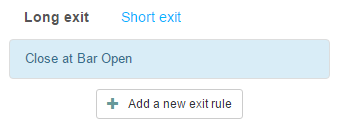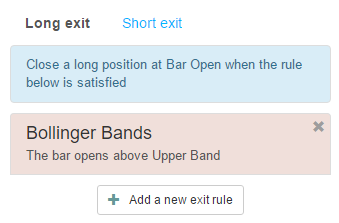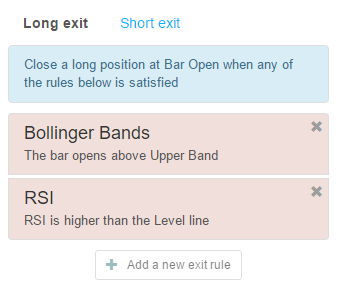Sidebar
This is an old revision of the document!
Table of Contents
Exit Rules
The Exit Rules are responsible for closing positions. There are only three possible points for closing a position: at Stop Loss, aт Take Profit and at Bar Open. Since the Stop Loss and Take Profit are part of the Expert Properties here we will describe only the Bar Open case.
No Exit Rule Indicators


When you create a new strategy it will contain no Exit rules and that is a perfectly valid exit condition. If there are no Exit rules the strategy will close all positions at the next Bar Open. This is indicated in the text “Close a long position at Bar Open”. This means that if the EA opens a position it will close it at the beginning of the next bar. This rule covers both long and short positions.
One Exit Rule Indicator
You can add Exit Rules indicators by using the “Add a new exit rule” button at the bottom of the Exit Rules list. You can't have more than two Exit Rules so the button becomes inactive when this limit is reached. When you click the button, the program opens an Exit Rule Indicator panel at the left side of the Editor. There you can choose an indicator and set its Logical condition and parameters.
All of the indicators express a Logical condition that can either be fulfilled or not fulfilled. When creating a strategy, you should cover the Long trading cases and the program will mirror the long rules for the short trades as well. In other words the strategy uses symmetrical conditions for long and short positions. The general case is that the condition is fulfilled for a short position but not for a long one or vice versa. In some cases, the condition can be fulfilled in both directions of trade at the same time (when using ADX for example).


The example above shows one Exit Rule indicator – Bollinger Bands, with a logical rule: “The bar opens above Upper Band”.
The condition “The bar opens above Upper Band” can be either true or false. If you have an open long position and it happens that the current bar opens above the upper Bollinger band, the expert will close that position at Bar Open with a market order.
Let's now imagine that we have a short position and the bar also opens above the Upper band. The rule in the indicator slot is satisfied for a long position, but it is not satisfied for a short one because your rule for short positions follows the opposite logic. If we have to put it explicitly: close short when “The bar opens below the Lower Band”. Because we are short and the exit rule doesn't allow closing short positions, the program leaves the position open for the next bar.
Two Exit Rules
When there are more than one Exit Rules, the program closes a position at Bar Open when at least one of these rules is satisfied. This is a key difference between the Entry and the Exit Rules. The program is very sensitive when it decides to close a position. No matter how many exit rules we have, only one of them is enough to close the position. Of course if both conditions are fulfilled the position is also closed.


Let's see a case when we have a long position and two Exit Rules. If the first of these is satisfied for a long position and the second one is satisfied for a short position. What do you think it will happen? The program will close the long position because a single signal for closing is enough, no matter what the second one is showing.